Pride and tears of Uva Wellassa
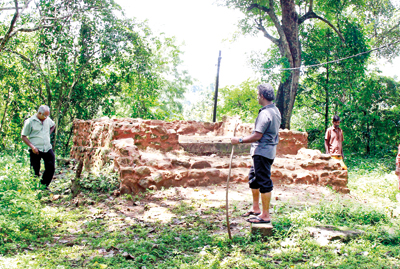
What remains of the Pattini devalaya
The awe-inspiring cloud covered mountains, lush forests, formidable waterfalls and clear streams of Uva Wellassa bear little testimony today to the darkest and bloodiest chapter in the country’s history under British rule. There is little sign of the burnt hamlets, scorched paddy fields, broken tank bunds, felled trees and the skeletons of the thousands of men, women and children killed or starved to death when the military might of the coloniser was turned on the population of the Kandyan provinces to put down a rebellion against British rule.
Two hundred years on, tales of the heroics of those who gave leadership to the Uva Wellassa rebellion and the suffering endured by their ancestors are well etched in the minds of the people of the Uva Province which is today made up of the Badulla and Monaragala districts.
The names of Kivulegedera Mohottala, Kohukumbure Rate Rala and Butawe Rata Rala, some of the leading figures in the rebellion are recalled fondly by those who take great pride in the role that they played in a last ditch effort to rid the Kandyan provinces of a foreign ruler.

A British cannon recovered from Wellassa. Pix by Indika Handuwala
R.M. Ukkumanika (98), a descendent of Kohukumbure Rate Rala lives in the village of Kohukumbura in the Monaragala District. Her sight and hearing are fading but her eyes light up when the name of her brave ancestor is brought up.
“My grandmother knew Kohukumbure Rate Rala and she would often tell us stories about his heroics. He was a well-built man and was not afraid of anyone. When the rebellion against the suddas (white man) began, he joined the struggle without any hesitation,” she said.
What helped the inhabitants of the area to hold out against foreign invaders were the natural barriers that kept their villages shielded from falling easy prey to attacks by British troops. The fighters used their intimate knowledge of the lands their ancestors had inhabited for hundreds of years to best use when they took up arms against the foreigners.
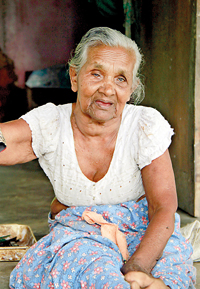
R.M. Ukkumanika: Recalling heroic tales of her ancestor Kohukumbure Rate Rala
The story goes that Kohukumbure Rate Rala drowned two British soldiers with his bare hands in a mud pit. “He left his family and joined the struggle knowing he could lose his life,” Ukkumanika said. In the village centre today stands a column erected in his memory, a lion figure to symbolise the strength of the man.
When the Kandy Convention or the Official Declaration of the Settlement of the Kandyan Provinces was signed on March 2, 1815, there was no foreboding that less than two years later many of the areas that the British sought to take over by “diplomatic’ means would be up in arms against them. The reasoning behind the Kandyan chieftains’ decision to sign an agreement with the British conceding their kingdom to an alien ruler was primarily to rid the country of Sri Wickrama Rajasinha, the Nayakkar king who, with his growing “independence and despotism” had attempted to undermine the power and diminish the influence of the oligarchy of Sinhalese aristocrats that surrounded his throne” says Colvin R. De Silva in his book ‘Ceylon under the British Occupation’.
The chieftains of Uva and Wellassa were among the signatories to the Convention but people by and large were disinterested or unaware of the details of the agreement. The Sinhala leaders saw it as a temporary arrangement. “The Kandyans used to inquire when the English intended to return to the Maritime Provinces. “You have now,” said one, “deposed the king, and nothing more is required – you may leave us,” wrote Henry Marshall, a British surgeon who served in the island between 1809-1821, in his book, “Ceylon– A general description of the Island and its inhabitants.”
Ven. Nuwaraeliye Chandajothi Thera of the Sri Jayatissa Bauddha Pirivena at Gawarammana, Keppitipola says the decision of the Chieftains to enter into an agreement with the British in 1815 was justified. “It is true that King Raja Sinha was a patron of Buddhism but during his rule many members of the Buddhist clergy were killed, temple property confiscated and all the power transferred to his Nayakkar relatives. The chieftains were disillusioned and wanted an indigenous ruler,” the Thera said.
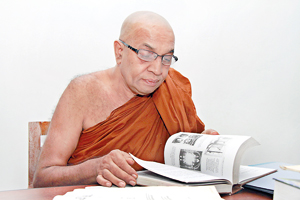
Ven. Nuwaraeliye Chandajothi Thera: A keen student of the uprising
A keen student of British rule on the island and in particular the rebellion, he prefers to call the uprising a “freedom struggle” and not a rebellion. “Throughout history, there were traitors who betrayed the cause but the Uva-Wellassa struggle was a display of the grit and might of the people,” the Ven. Thera says.
Ironically, Ven. Chandajothi’s Pirivena is housed today in what was once the official residence of Sylvester Douglas Wilson, the Agent of the British
Government in Uva. The fate that befell Wilson at the hands of the rebels is closely linked to the brutal backlash that the locals suffered at the hands of foreign troops months later.
The English official had left “Wilson Bungalow on October 14, 1817 to inquire into reports of growing unrest in the interiors of Wellassa with a party of Malaya solders, under the command of Lieutenant Newman, and attended by an interpreter and some native lascoreyns,” according to Henry Marshall. Today the distance between Keppitipola and Badulla is about 55 kilometres along well tarred roads but in 1817 it was a long ride on horseback through winding, marshy jungle paths.
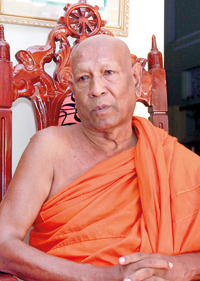
Ven. Hewilvila Sunanda Nayaka Thera
Nandasena Herath, a retired bank manager in Bibile and a descendent of Kivulgedera Mohottala reveals more of Wilson’s fateful journey to the heartland of the rebellion. “We know that Sylvester Wilson sudu mahattyaa came to hold discussions with the rebel leaders. On the way he had met with Kohukumbure Rate Rala and with the information gathered from him he rode on to the next village where he met with Butawe Rate Rala. It was evening by the time he reached Unagolla. After many weary hours of riding, the group had retired for the night to their shelters,” Mr. Herath said.
The next morning, while the rest of the detachment moved forward, Wilson, attended by two servants, had stopped at a spring to quench his thirst, when an arrow shot from a distance pierced his head and he fell dead. One of the servants too was killed while the other fled the scene to alert those who had proceeded ahead of them.
“We know that Newman came back as quickly as he could when he was alerted to what happened but by then Wilson’s body was not to be found,” Herath said.
Marshall writes that Wilson’s body had been dragged to the jungles by the rebels and even though the British officers searched till sunset there were no signs of where it was.
A golden statue of Meegahapitiya Waluwe Hitihamy Mudiyanse Rate Rala, the man who is believed to have shot the arrow that felled Wilson stands on a rock on the outer border of the Unagolla Purana Viharaya in Bibile.
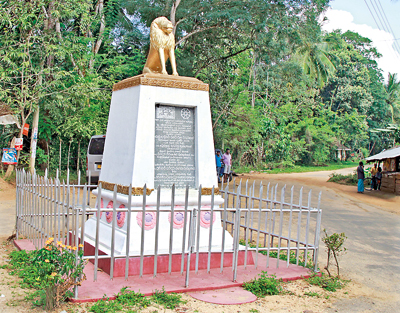
The memorial column for Kohukumbure Rate Rala
Ven. Hewilvila Sunanda Nayaka Thera, the chief incumbent of the Unagolla Viharaya gives more details about what led to animosity between the British and the locals. “When travellers arrived from different parts of the country, they would rest in this village for a day or two. This is because from here on the land is mountainous and it is a tedious upward journey. Over time , a barter system had developed between the villagers and the carters who came into this area with the villagers giving them produce such as vegetables and paddy from their land in exchange for dry fish, dhal, salt and other commodities which they had no access to in the interiors. However a
dispute resulted after a British crony intent on becoming the chief trader in the area poisoned the minds of his masters which led to the barter system being stopped. Angered by this, the villagers grew hostile towards the British,” the Thera explained.
While British writers on the incident have stopped with the disappearance of Wilson’s body, Sunanda Thera says that according to village lore the rebels had dragged the body towards the “Pattini devalaya” which is a short distance from where the man was felled, beheaded him and offered his head as a sacrifice to the devalaya. “The message to the white man was clear. Don’t come back to Wellassa,” the Thera said.
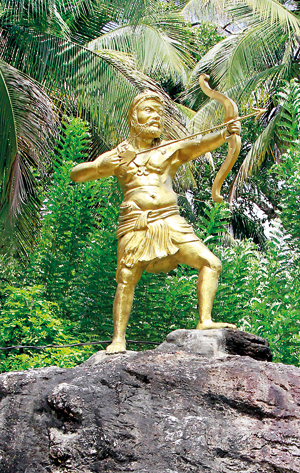
Meegahapitiya Waluwe Hitihamy Mudiyanse Rate Rala: The man who is believed to have felled Sylvester Douglas Wilson
Little remains of the devalaya now and access is still difficult: a trek through a jungle path and wading across a shallow river. At the place where Wilson fell stands a column erected by the British in 1912 “in memory of Sylvester Douglas Wilson …. Who was killed near the spot at the outbreak of the Kandyan rebellion?”
Mr. Herath says that plans had been afoot for months to wage war on the British before Wilson’s killing with
small groups of villagers gathering to discuss ways to oust the invaders. The killing of Wilson was a turning point because the rebel leaders were keen to get a high profile target which they achieved. It helped their morale but it also brought the full wrath of the British military might on them,” Mr Herath said.
By November, 1817, alarming reports were reaching the British Governor in Ceylon Sir Robert Brownrigg that a pretender named Duraisami, claiming to be of royal descent had proclaimed himself king and had the support of the people of Uva and Wellassa. The Disava of Uva Keppitipola was entrusted with authority in these two areas and dispatched to quell the unrest. Keppitipola soon joined the rebellion prompting Brownrigg, by proclamation, to outlaw him and 18 headmen while confiscating their property and with offer of monetary rewards for those who apprehend them and assisted to suppress the rebellion. Under Keppitipola’s leadership, the rebellion grew in strength and spread to several areas outside Uva –Wellessa. In February, 1818, the whole of the Kandyan provinces was placed under martial law by Brownrigg. While the Kandyans used guerilla tactics to wage their battle, unable to deal with an elusive enemy, the British decided to starve and terrorise the local population into submission.
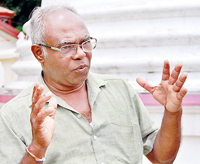
Nandasena Herath: Descendent of Kivulgedera Mohottala
Colvin R. De Silva wrote that British policy developed rapidly into plain terrorism as the rebels began to make inroads into more and more areas in the Kandyan provinces. “Wherever they went, they carried away or destroyed all cattle and stores of grains or provisions that they found, villagers were wiped out, houses were burnt down, crops devastated, fields permanently ruined by damaging the irrigation system, fruit trees cut down and livestock killed, so as to starve and terrorize the inhabitants into submission,” he wrote.
With reinforcements from India arriving in mid -1818, the rebellion began to lose momentum as one by one the provinces began to be subdued while others surrendered, choosing to accept an amnesty granted by the British.
The death knell of the rebellion came on November 22,1818 when the British recaptured the Sacred Tooth Relic which had been spirited away from the Dalada Maligawa during the rebellion. “The event had a singular effect upon all classes, being considered a sign of the destiny of the British people to rule the Kandyan,” writes De Silva.
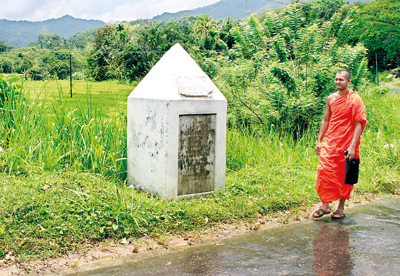
A column stands on the spot where Sylvester Douglas Wilson was killed
Keppitipola was arrested and tried by a court martial on November 13, 1818 and was executed on November 25. Martial law was revoked by a proclamation on November 21, 1818 but was finally and completely withdrawn only two years later in 1820 throughout the Kandyan provinces.
The human toll of the rebellion was massive. English writers have put the death toll at 10,000 for the fighters as against 1000 of their men. This, at a time when the country’s entire population was under three million.
Nandasena Herath, whose ancestor Kivulegedera Mohottala was among 32 rebel leaders banished to Mauritius after the rebellion was put down laments the plight of his beloved Uva Wellassa, not only for its past but its present.
“The Uva province remains the most backward and least developed area in the country till today. What the British did was 200 years ago but in the 70 years since independence, these areas have been neglected by successive governments. The plight of the people still remains as precarious as it was under British rule,” he says.


